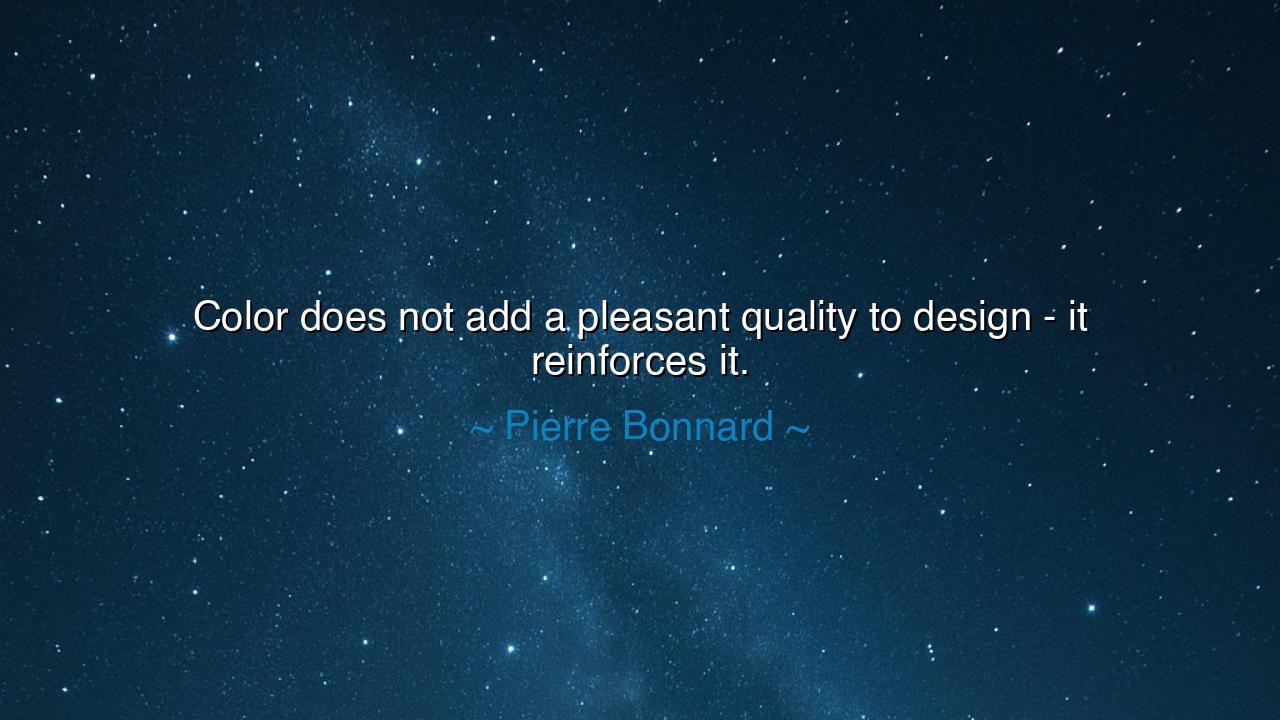
Color does not add a pleasant quality to design - it reinforces






“Color does not add a pleasant quality to design — it reinforces it.” — Pierre Bonnard
Thus spoke Pierre Bonnard, the quiet alchemist of light, whose canvases shimmered with warmth and life. In this profound declaration, he reveals a truth known to all great creators but grasped by few: that color is not an ornament to design, not a mere garment draped upon form, but its living soul — the force that gives structure breath and emotion. When Bonnard says, “Color does not add a pleasant quality to design — it reinforces it,” he reminds us that beauty is not found in decoration, but in harmony — in the deep, invisible connection between form and feeling, thought and tone, structure and spirit.
The origin of this wisdom lies in Bonnard’s devotion to the art of color itself. A painter of the post-impressionist age, he stood between the classical and the modern, between restraint and radiance. His world was filled not with lines of logic, but with light that danced — light that revealed emotion as vividly as it revealed shape. He saw that design — whether in art, architecture, or life itself — gains strength not from embellishment, but from unity, where every element serves the whole. Thus, for Bonnard, color was not an afterthought; it was the heartbeat that made the body of design come alive.
To reinforce design through color is to understand that color holds weight, mood, and meaning. It can calm or awaken, soothe or disturb, exalt or destroy. The ancients, too, knew this truth. The Egyptians painted their temples with golds and blues to echo the heavens and the sun; the Greeks adorned their statues not in pale marble, but in vivid hues to reflect divine vitality. In every age, the wise have known that color shapes the soul of a space, the tone of a story, the rhythm of a life. Bonnard, inheriting this ancient lineage, declared that color’s purpose is not to charm but to strengthen — to deepen the power of design, to bind together vision and emotion.
Consider the work of Le Corbusier, the architect who transformed concrete into poetry. He believed, as Bonnard did, that color was structure — that it could guide the eye, sculpt space, and evoke feeling. In his buildings, walls painted in ochres, greens, and ultramarines were not decorative; they defined purpose, marked transitions, and shaped experience. The colors did not please for their own sake; they revealed order within chaos, balance within boldness. Such harmony is what Bonnard sought — the point at which color becomes not surface, but substance.
There is also a spiritual dimension in Bonnard’s insight. To him, color was not confined to the visual world — it was a reflection of life’s vitality, of the pulse that runs through all living things. He saw color as the emotional truth of existence — as music made visible. The careless hand uses color to decorate; the wise hand uses it to speak. The same is true in life: those who chase adornment lose authenticity, but those who reinforce their purpose with truth and emotion create beauty that endures. Color, in this sense, is a metaphor for sincerity — for the vivid honesty that gives design, and life itself, meaning.
The lesson is this: in all acts of creation, seek not the pleasing, but the powerful. Do not paint your work — or your life — with superficial brightness, but with depth, intention, and balance. Let your “colors” — your choices, your emotions, your expressions — serve the form of your purpose. In art, as in living, every hue must strengthen the whole. The truest beauty is not in what dazzles, but in what endures through harmony.
So remember the teaching of Pierre Bonnard: “Color does not add a pleasant quality to design — it reinforces it.” In this truth lies a sacred principle — that beauty without purpose is emptiness, and purpose without expression is silence. When you create — whether a painting, a home, a dream, or a life — do not merely add color for pleasure. Choose it for strength. Let every shade of your being reflect intention, let every line of your work echo meaning. For the greatest art — and the greatest life — is not a spectacle of decoration, but a symphony of unity, depth, and soul.






AAdministratorAdministrator
Welcome, honored guests. Please leave a comment, we will respond soon